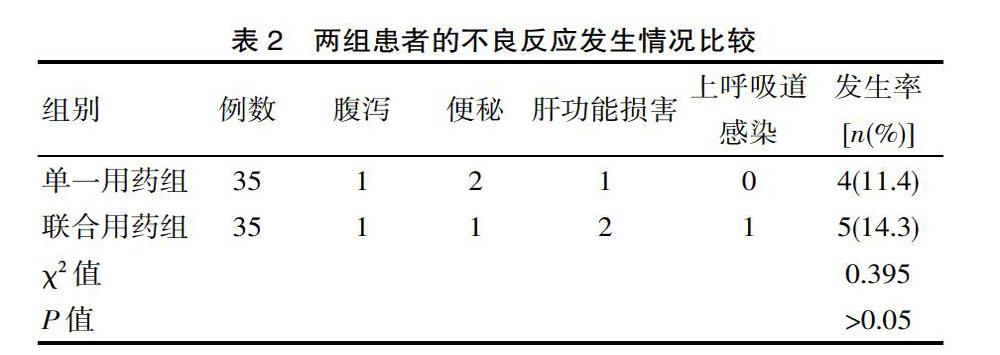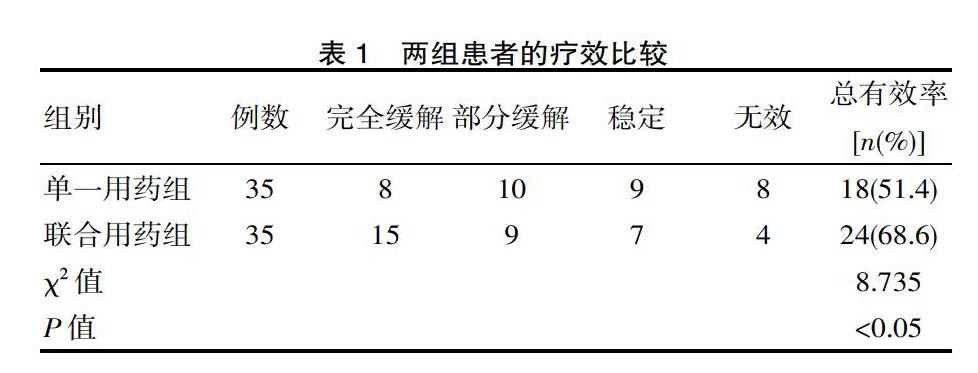探讨三氧化二砷联合沙利度胺联合治疗骨髓增生异常综合征的疗效
2020-07-15朱翠霞
朱翠霞


[摘要] 目的 对在骨髓增生异常综合征的治疗中应用三氧化二砷和沙利度胺联合治疗的效果进行分析和研究。方法 便利选择该院收治的骨髓增生异常综合征患者共计70例作为该次研究的納入对象,选取时间段为2017年1月—2019年6月,按照随机数字表法将这些患者划分为联合用药组和单一用药组,每组35例。采用沙利度胺对单一用药组患者进行治疗,在此基础上,联合应用三氧化二砷治疗联合用药组患者,对两组患者的治疗效果进行分析和比较。结果 单一用药组中有8例完全缓解、10例部分缓解、9例稳定、8例无效,共计达到了51.4%的总有效率,联合用药组中有15例完全缓解、9例部分缓解、7例稳定、4例无效,共计达到了68.6%的总有效率,联合用药组的总有效率明显高于单一用药组,组间差异有统计学意义(χ2=8.735,P<0.05)。单一用药组中共计有1例腹泻、2例便秘、1例肝功能损害,共计达到了11.4%的不良反应发生率,联合用药组中共计有1例腹泻、1例便秘、2例肝功能损害、1例上呼吸道感染,共计达到了14.3%的不良反应发生率,联合用药组的不良反应发生率与单一用药组相比略高,差异无统计学意义(χ2=0.395,P>0.05)。结论 在骨髓增生异常综合征的临床治疗中采用氧化二砷和沙利度胺联合治疗具有很好的效果,而且安全性更好。
[关键词] 骨髓增生异常综合征;三氧化二砷;沙利度胺;联合用药
[Abstract] Objective To analyze and study the effect of arsenic trioxide and thalidomide combined treatment in the treatment of myelodysplastic syndromes. Methods A total of 70 patients with myelodysplastic syndromes treated in the hospital were convenient selected as the subjects of this study. The period of time was from January 2017 to June 2019. These patients were divided into a combination drug group and single-dose group according to the random number table method, with 35 patients in each group. The thalidomide was used to treat patients in the single drug group. Based on this, arsenic trioxide was used in combination with the patients in the drug group to analyze and compare the treatment effects of the two groups of patients. Results Eight patients in the single-medicine group had complete remission, 10 patients had partial remission, 9 patients were stable, 8 patients were ineffective, and a total effective rate of 51.4% was achieved. 15 patients in the combination group had complete response, 9 patients had partial response, 7 cases were stable and 4 cases were ineffective, reaching a total effective rate of 68.6%. The total effective rate of the combined drug group was significantly higher than that of the single drug group, and the difference was statistically significant(χ2=8.735, P<0.05). There were 1 case of diarrhea, 2 cases of constipation, and 1 case of liver function impairment in the monotherapy group, with a total incidence of adverse reactions of 11.4%. The combined group had 1 case of diarrhea, 1 case of constipation, and 2 cases of liver function impairment, 1 case of upper respiratory tract infection, a total of 14.3% of adverse reactions occurred. The incidence of adverse reactions in the combined drug group was slightly higher than that in the single drug group, but it was found to have no statistically significance after experience (χ2=0.395, P>0.05). Conclusion The combined treatment of arsenic oxide and thalidomide in clinical treatment of myelodysplastic syndrome has good effect and better safety.
